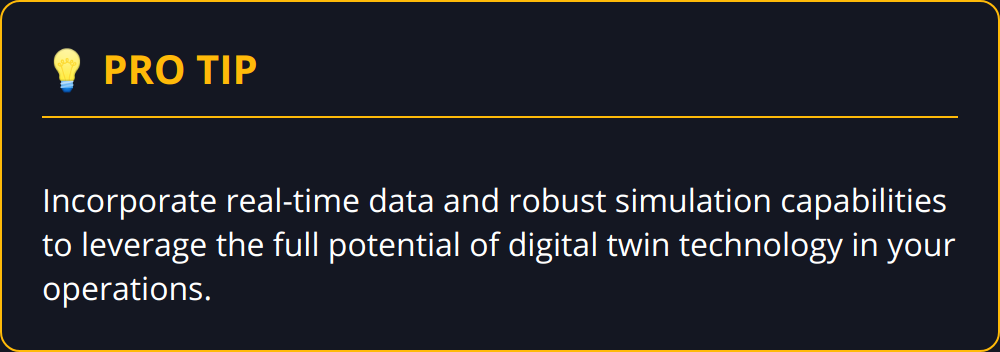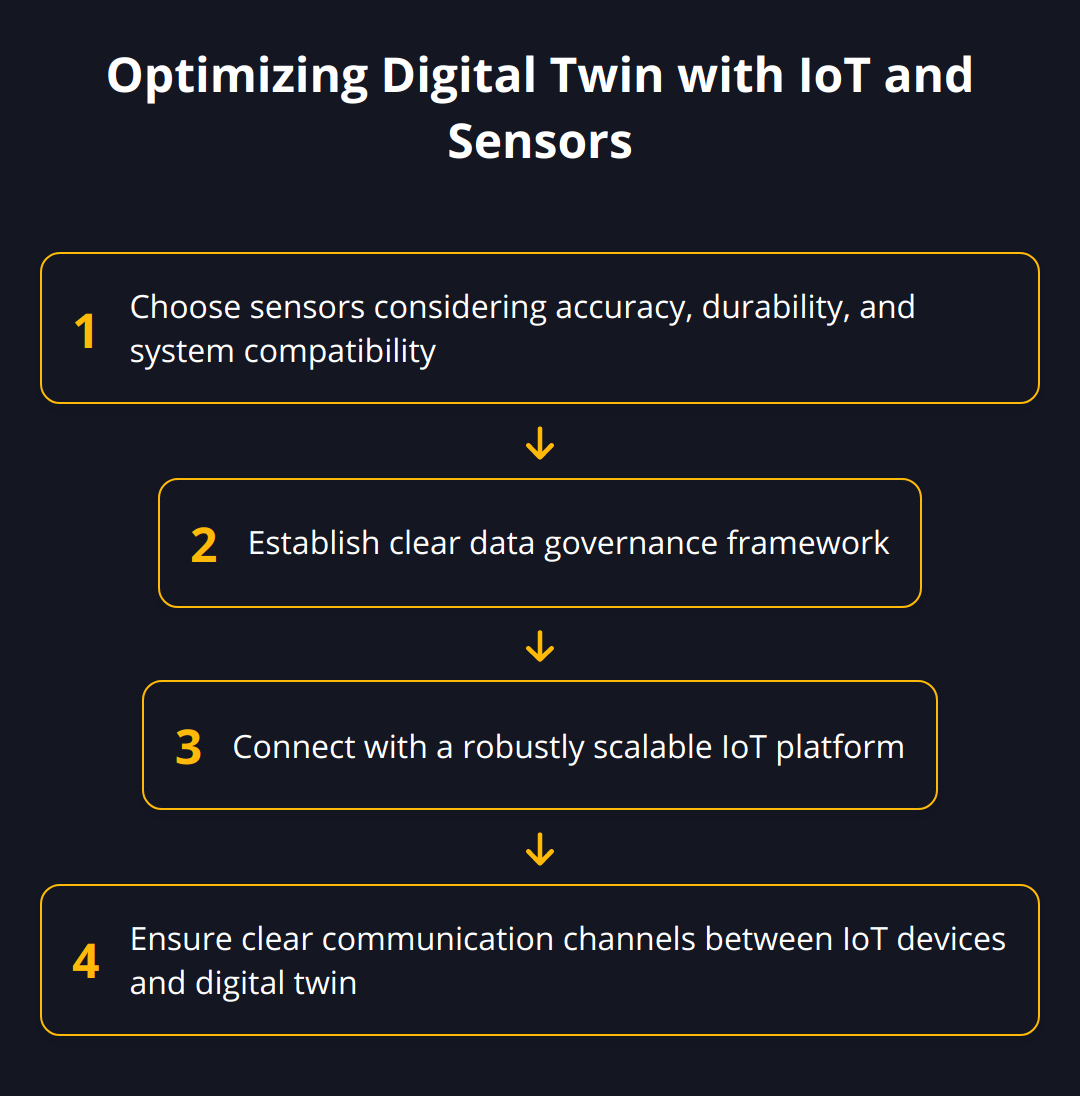We at Newroom Connect understand that adopting new technology can be a strategic move. Digital twin technology stands out for its potential to revolutionize various industries by bridging the physical and digital worlds.
This blog post offers a straightforward guide to implementing digital twin technology, covering everything from the basics to execution. We will provide you with actionable insights to help navigate this transformative journey, focusing on tangible benefits and practical steps.
Grasping Digital Twin Technology
Digital twin technology is no mere buzzword; it is a transformative tool that enables a deeper understanding and real-time control of physical systems. Essentially, a digital twin is a dynamic virtual model that mirrors a physical object, process, or system. At its core, the digital twin relies on data—lots of it. By harnessing sensor input and other data forms, digital twins evolve, incorporating insights from machine learning and artificial intelligence to optimize operations and predict future states.
Let’s break down the essential components. Every digital twin integrates:
-
Real-time data: Quantum leaps in IoT capabilities mean that a plethora of devices can now provide the timely data that digital twins feast on.
-
Simulation capabilities: This is where the predictive power of digital twins shines, presenting scenarios that guide decision-making without risking real-world assets.
-
Integration: A digital twin must harmonize with existing systems for a seamless flow of information. No digital twin is an island; it requires synchrony with broader ecosystems to add value.

From their inception, digital twins have markedly evolved. Initially, they were mere static representations, but now they are dynamic powerhouses of predictive analytics and deep learning. Initially a niche concept in aerospace for twin engine monitoring, digital twins have spread their wings into numerous sectors, including manufacturing, healthcare, and urban planning. Studies like those by Gartner predict that by 2022, over 70% of companies using IoT will have started experimenting with digital twins.

The applications we see today are just the tip of the iceberg. In the field of manufacturing, for example, the implementation of digital twins has spiked productivity and operational efficiency by enabling predictive maintenance and reducing downtimes. Reports indicate that predictive maintenance can diminish maintenance costs by up to 25%, reduce breakdowns by up to 70%, and lower downtime by up to 50%.
In healthcare, digital twins are customizing patient treatments and advancing the development of medical equipment. Their ability to simulate and analyze unique patient conditions contributes to personalized medicine, potentially lowering treatment costs and improving outcomes.
Real estate and urban development have also harnessed the power of digital twins to optimize energy usage, manage resources effectively, and enhance building operations, contributing significantly to sustainable development goals.
As we continue to deploy and refine digital twin technology, keep an eye on these rapidly surfacing trends:
-
Scaling up: As enterprises aim to replicate larger and more complex systems, digital twins are bound to become more intricate and interconnected.
-
Empowered by AI: The fusion of AI with digital twins introduces self-learning abilities, elevating the tech from being reactive to proactive.
-
Enhanced Interoperability: Expect broader integration with myriad data sources and systems, pushing digital twins towards a universally compatible tool across various platforms.
Navigating through the world of digital twin technology means staying attuned to these trends and aggressively adopting the tech to keep up with, if not outpace, the competition. It’s also about understanding the potential digital twins have for your enterprise, pinpointing the tangible benefits they offer in insight, foresight, and operational readiness. Whether it’s preempting equipment failure or personalizing customer experiences, digital twins represent a strategic investment in a future where the virtual and physical realms are seamlessly aligned for peak performance and innovation.
Is Your Business Ready for a Digital Twin?
Implementing digital twin technology requires preparation and strategic planning. Organizations must assess their readiness and carefully choose tools that align with their specific goals. This preparation ensures the digital twin serves its intended function, transforming business processes and unlocking innovation.
Evaluating Organizational Alignment
Embarking on the digital twin journey starts with evaluating organizational alignment. Companies need to ensure their objectives are clear and that there is a solid foundation for digital transformation. This process involves:
-
Defining precise business objectives.
-
Identifying key stakeholders and getting their buy-in.
-
Reviewing existing data infrastructures.
-
Designing a roadmap tailored to specific goals.
One practical method to assess readiness is conducting a gap analysis. This analysis reveals the distance between where your organization currently stands and where it needs to be to effectively use a digital twin. Keep in mind that the maturity level of your existing systems does not necessarily impede your ability to leverage digital twins effectively. Even with less mature systems, there is potential to achieve substantial progress if the digital twin is implemented thoughtfully, focusing on specific use cases and objectives.
Companies should also consider the talent and skills within their workforce. The creation and management of digital twins require specialized skills. Thus, investing in training or hiring new talent is critical for a successful implementation.
Choosing the Right Digital Twin Platform

The next step is selecting the appropriate digital twin platform and tools. Not all platforms are created equal, and your choice will significantly influence the success of the digital twin. Here’s how to approach this selection process:
-
Determine compatibility with current systems.
-
Look for platforms that offer scalability to grow with your business needs.
-
Assess the level of support and community around the platform.
-
Consider the long-term viability of the vendor.
It’s essential to opt for a platform that integrates well with your current technological ecosystem. Effective data sharing and communication between systems are key to a digital twin’s utility.
When exploring tools, businesses should place a premium on real-time data processing and simulation capabilities. Platforms that enable advanced analytics and machine learning can exponentially increase the potential of your digital twin.
Utilize case studies to understand how similar organizations have benefited from digital twin technology. For instance, Siemens’ use of digital twins in their manufacturing processes highlights the operational efficiencies and cost savings achievable.
A critical reminder is to prioritize cybersecurity features within digital twin platforms. As reported, cyberattacks on IoT devices are on the rise, underlining the need for robust protection.
Tips for Implementation Success
To wrap up, here is a concise list of tips to guide your digital twin implementation process:
<>
In conclusion, a well-thought-out approach to digital twin implementation can position your business to reap the significant benefits this technology has to offer. Focus on readiness, strategic alignment, and the selection of the right platform to facilitate a smooth transition into the world of digital twins.
Executing Your Strategy
Successfully executing a digital twin strategy hinges on the integration of IoT and sensor technology coupled with ensuring data accuracy for real-time analysis. Real progress is seen when systems not only gather data but also act upon it intelligently and autonomously.
Optimizing with IoT and Sensors
Internet of Things (IoT) and sensors are the lifelines of a digital twin, providing the constant stream of data that breathes life into the model. Here are key steps to achieve seamless integration:
-
Choose sensors wisely, considering their accuracy, durability, and compatibility with your systems. Your operations are only as good as the data they receive.
-
Establish clear data governance. This framework should dictate who has access to data, how it’s managed, and the ways in which it’s protected.
-
Connect with an IoT platform that offers robust scalability and support, like those mentioned in our post on digital twin platforms.
Ensuring clear channels of communication between your IoT devices and the digital twin is non-negotiable. Discrepancies in data transfers can lead to a domino effect of inaccuracies, rendering your digital model less predictive and more problematic.

Pursuing Data Precision
Turning data into actionable intelligence is the crowning attribute of digital twins. Concentrate on these areas:
-
Engage data scientists to process and fine-tune the incoming information. Remember, raw data is a rough diamond; refining it is necessary.
-
Leverage machine learning for dynamic data analysis. AI is transformative when coupled with real-time data, adapting to changing conditions on the fly.
-
Regularly validate your twin against real-world scenarios. If the virtual doesn’t measure up to the physical, recalibrate until it does.
Missteps in data analysis can lead to misguided decisions. It’s not just about having data; it’s about having the right data at the right time. Fail to adhere to this, and you risk not just inefficiencies, but potentially catastrophic errors.
In summary, a robust digital twin strategy rests on the precision and interplay of data and technology. Implemented thoughtfully, it catalyzes smarter decision-making, uncovers hidden efficiencies, and sets the stage for unprecedented innovation. The recipe for success is clear-cut: integrate diligently, analyze fearlessly, and refine relentlessly.

Wrapping Up
Reflecting on the journey of digital twin implementation we’ve outlined, it’s evident that the long-term value of this technology extends far beyond the immediate benefits. Digital twins possess the potential to become the cornerstone of strategic decision-making, offering a depth of insight that previously seemed unattainable.

By capturing the nuances of complex systems and processes, digital twins allow organizations to simulate, predict, and evolve in ways that significantly elevate efficiency and innovation. The practical impact is clear in the accuracy of forecasting, personalized customer experiences, and the ability to conduct scenario analyses without the constraint of the physical environment.
However, to harness the full spectrum of possibilities that digital twins offer, a commitment to continual learning and adaptation is essential. As technology races forward, keeping pace means integrating the latest advancements and refining your digital twin to reflect these changes.
We at Newroom Connect champion the belief that innovation is a continuous pursuit. Our platforms are designed with the future in mind, ensuring your business can confidently navigate the complexities of the virtual space with tools like virtual trade fairs and e-learning platforms. Creating a digital twin with our digital twin solution sets the groundwork for insightful analytics and offers a competitive edge that evolves with your enterprise.
In conclusion, the digital twin is much more than a one-time project; it’s an ongoing strategy that can drive businesses into a future where real-time intelligence and decision-making are the norms. It propels companies toward a horizon where agility, foresight, and innovation intersect, offering a tantalizing glimpse into a world where the physical and digital converge seamlessly. As you forge ahead, we invite you to partner with us at Newroom Connect, where we strive to turn the virtual into a powerful reality for your business.


